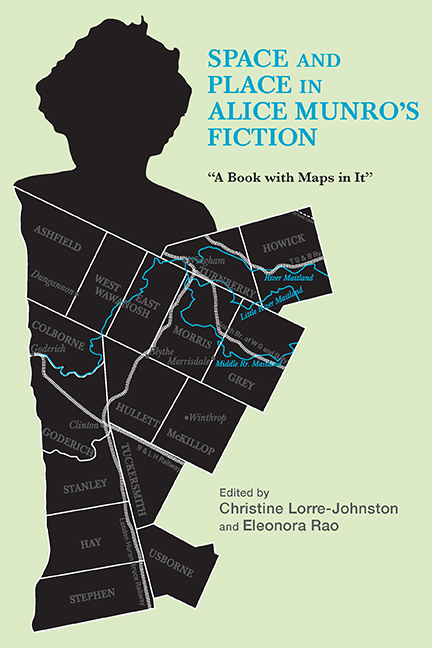Book contents
- Frontmatter
- Contents
- List of Illustrations
- Acknowledgments
- List of Abbreviations
- Introduction
- Part I Conceptualizing Space and Place: Houses, Landscapes, Territory
- 1 Where Do You Think You Are? Alice Munro's Open Houses
- 2 “Whose House Is That?” Spaces of Metamorphosis in Alice Munro's Dance of the Happy Shades, Who Do You Think You Are?, and The View from Castle Rock
- 3 Mapping the Vernacular Landscape in Alice Munro's “What Do You Want to Know For?” and Other Stories
- 4 Stories in the Landscape Mode: A Reading of Alice Munro's “Lives of Girls and Women,” “Walker Brothers Cowboy,” and “Lichen”
- 5 “What Place Is This?” Alice Munro's Fictional Places and Her Place in Fiction
- 6 “The Emptiness in Place of Her”: Space, Absence, and Memory in Alice Munro's Dear Life
- 7 Down the Rabbit Hole: Revisiting the Topos of the Cave in Alice Munro's Short Stories
- Part II Close Readings of Space and Place
- Bibliography
- Notes on the Contributors
- Index
5 - “What Place Is This?” Alice Munro's Fictional Places and Her Place in Fiction
from Part I - Conceptualizing Space and Place: Houses, Landscapes, Territory
Published online by Cambridge University Press: 15 August 2018
- Frontmatter
- Contents
- List of Illustrations
- Acknowledgments
- List of Abbreviations
- Introduction
- Part I Conceptualizing Space and Place: Houses, Landscapes, Territory
- 1 Where Do You Think You Are? Alice Munro's Open Houses
- 2 “Whose House Is That?” Spaces of Metamorphosis in Alice Munro's Dance of the Happy Shades, Who Do You Think You Are?, and The View from Castle Rock
- 3 Mapping the Vernacular Landscape in Alice Munro's “What Do You Want to Know For?” and Other Stories
- 4 Stories in the Landscape Mode: A Reading of Alice Munro's “Lives of Girls and Women,” “Walker Brothers Cowboy,” and “Lichen”
- 5 “What Place Is This?” Alice Munro's Fictional Places and Her Place in Fiction
- 6 “The Emptiness in Place of Her”: Space, Absence, and Memory in Alice Munro's Dear Life
- 7 Down the Rabbit Hole: Revisiting the Topos of the Cave in Alice Munro's Short Stories
- Part II Close Readings of Space and Place
- Bibliography
- Notes on the Contributors
- Index
Summary
ROBERT THACKER DESCRIBES Munro's story “The Peace of Utrecht” (Dance of the Happy Shades, 1968) as “one of the first stories to establish Munro's characteristic use of place.” The setting of the story is the town of Jubilee, to which the heroine returns after a long absence, during which her mother has died. The town's constancy bestows upon it something of the eternity of nature with which it seems to be one: “The rhythm of life in Jubilee is primitively seasonal. Deaths occur in the winter; marriages are celebrated in the summer. There is a good reason for this; the winters are long and full of hardship and the old and weak cannot always get through them” (DHS, 194). The symbiosis between human beings and nature represents the reconciliation between the insecurity of the vast, untamed natural space and the homely and emotionally bonding place in which the human being can feel protected. The heroine rediscovers her connection to her place of origin in its eternal rhythms and in the memory of her late mother who “became one of the town's possessions and oddities, its brief legends” (DHS, 194). The story thus sets the frame of what early critics perceived as Munro's regionalism, in which place is the one constant, impossible to erase from oneself, that facilitates a kind of metaphysical recognition, beyond the realms of words and logic but essential for one's understanding of life.
Such an apparently immovable place as described by Munro in the quotation from “The Peace of Utrecht” above is, first of all, merely one kind of place featured in Munro's fiction, and, second, a highly unlikely construction in sociological terms. It is the opposite of what the human geographer Doreen Massey labels “a progressive concept of space.” In her definition, places are “absolutely not static,” they “do not have to have boundaries in the sense of divisions which frame simple enclosures,” they “do not have single, unique ‘identities’; they are full of internal conflicts,” and “none of this denies place nor the importance of the uniqueness of place.”
- Type
- Chapter
- Information
- Space and Place in Alice Munro's Fiction“A Book with Maps in It”, pp. 100 - 118Publisher: Boydell & BrewerPrint publication year: 2018



